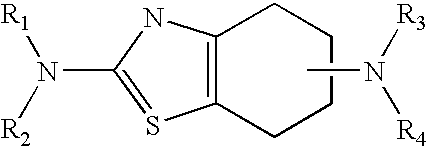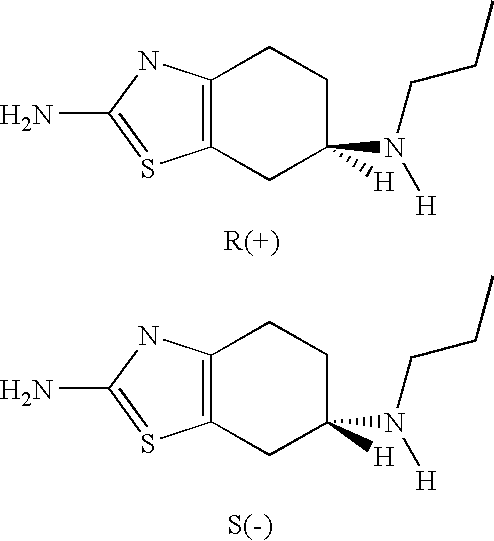Neurorestoration with R(+) Pramipexole
a technology of pramipexole and neuroneural stimulation, which is applied in the field of pramipexole (2amino4, 5, 6, 7tetrahydro6propylaminobenzathiazole), can solve the problems of autosomal genetic pathogenesis, few therapies developed, and decline of function
- Summary
- Abstract
- Description
- Claims
- Application Information
AI Technical Summary
Benefits of technology
Problems solved by technology
Method used
Image
Examples
example 1
Clinical Studies of R(+) Pramipexole
[0074] Phase I clinical studies with R(+) pramipexole were conducted in patients with amyotrophic lateral sclerosis (ALS), a fatal adult neurodegenerative disease arising from the loss of motor nerve cells. During the studies, it was found that the approximately half the patients treated with 30 mg / day of R(+) pramipexole for up to 8 weeks reported improvements in motor function. These reports included such things as regaining the ability to speak coherently, the ability to climb stairs again, and improved motor skills in their extremities, i.e. hands and / or fingers. This data indicates that rather than simply slowing the loss of function, R(+) pramipexole improves and restores function in an otherwise rapidly progressive neurodegenerative disease.
PUM
| Property | Measurement | Unit |
|---|---|---|
| enantiomeric excess | aaaaa | aaaaa |
| enantiomeric excess | aaaaa | aaaaa |
| enantiomeric excess | aaaaa | aaaaa |
Abstract
Description
Claims
Application Information
 Login to View More
Login to View More - R&D
- Intellectual Property
- Life Sciences
- Materials
- Tech Scout
- Unparalleled Data Quality
- Higher Quality Content
- 60% Fewer Hallucinations
Browse by: Latest US Patents, China's latest patents, Technical Efficacy Thesaurus, Application Domain, Technology Topic, Popular Technical Reports.
© 2025 PatSnap. All rights reserved.Legal|Privacy policy|Modern Slavery Act Transparency Statement|Sitemap|About US| Contact US: help@patsnap.com



